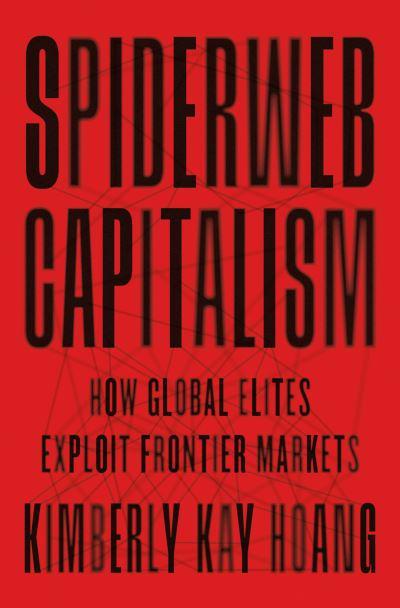Richard Godden: “Spiderweb Capitalism” by Kimberly Kay Hoang

Kimberly Kay Hoang is an Associate Professor of Sociology at the University of Chicago. In Spiderweb Capitalism, she both describes and draws conclusions from her research into the way in which business is conducted in Vietnam and Myanmar. Some of her conclusions do not follow from her findings, her terminology and analysis is laden with ideology and the metaphor of a spider’s web that she uses throughout the book is ear-tingling but misleading. Nonetheless, the book should be read by everyone who wishes to be aware of the problems associated with business in emerging markets, especially those who are involved in making decisions as to what business they should conduct in such markets.
Hoang poses the question “How do global elites capitalise on risky frontier markets?” and says that her goal is “to uncover the structure of the networks… to examine the people who make and move the money around the world through offshore vehicles, and… to reveal how elites finesse the gray space between legal and illegal practices to establish significant social and political connections that allow them to exploit new frontiers” (page 2).
To this end, Hoang spent several years seeking to get under the skin of business in Vietnam and Myanmar, primarily by means of a large number of discussions (sometimes lasting many hours) with founders of businesses, investors, managers, fixers and various types of professional advisers, including people based both on-shore and off-shore. She provides interesting descriptions of her methodology, the challenges that she faced in conducting research without herself becoming implicated in illegal activity and the limitations that she laboured under. The limitations were significant but it is astonishing how much Hoang managed to persuade people to discuss with her. She ponders on the reasons why they were prepared to do this and recognises the possibility that it was of some assistance that she is a woman and may, perhaps, have been less threatening to some interviewees than a man might have been. She also notes that her University of Chicago connection may have helped since “The dominant reputation of [the University] often clouded my status as a ‘leftie sociologist’ critical of elites” (page 231).
The majority of the book comprises of descriptions she was told and otherwise found out during her research. These are grouped broadly around various topics (e.g. how deals are set up, types of corruption and bribery, and tax strategies). Hoang’s style is, at times, journalistic (e.g. “It was 5:00p.m., the sun was setting…”, page (xi)) and she tells her stories well. She also seeks to set the context of her various interviews and give insights into the life and character of the various people she encountered. This both makes her accounts more interesting and provides helpful context.
One of the strengths of her accounts is that she does not deal in caricatures. She comments that she “came to understand that [the individuals involved in emerging market business] were complex, multi-dimensional people” and that “Caricatures of them that I had read both in books and in the public media did not quite resonate with my experience spending hours talking to people” (page 169). It is in this spirit that Hoang seeks to understand how the various actors rationalise their activities and even, in some cases, compartmentalise their lives so as to keep a distance between their “playing in the gray” (as she calls their activities) and their home or other private lives. She also recognises a spectrum of willingness to play in the gray: “anti-corrupters”, “greasers” and “bribers” being among the possibilities.
Likewise, Hoang acknowledges that business activities in emerging markets are themselves legally and morally more complex than is sometimes suggested. For example, it is good to see her recognising that some complex structures serve “pragmatic functions beyond secrecy and evasion… [which] include privacy, tax concerns, finessing weak local banking institutions, off-shore arbitration, access to a wider pool of global investors, asset protection from law suits, easier off-shore exits, and the ability to send and receive payment in private through designated nominees”. She also appears to accept the difference between the ensuring of secrecy (because there is something nefarious to hide) and a desire for privacy.
Readers need to be on their guard in relation to Hoang’s use of terminology, which in some cases does not correspond to normal business usage. For example, she describes transfer pricing as an accounting practice designed “to legally write off parts of the costs of the business”, (page 126). She also quotes one of her contacts as saying that “a special purpose vehicle is a paper company set up off-shore” (page 4) and appears to have adopted this definition, which may be useful in the context in which she was operating but is a very narrow conception of a special purpose vehicle.
More seriously, Hoang sometimes fails adequately to distinguish legal from illegal activities and she has a tendency to overstatement. For example, although in one place she recognises that the limited partners of an investment entity may comprise pension funds and other institutions, she focuses on individuals who are limited partners, stating that “they are all global citizens who claim citizenship in one or two countries but regularly travel all around the world” (page 28), which is unhelpful since it does not reflect the reality of many investment funds or their investors. She also states that “the world is now divided between [High Net Wealth Individuals] and poor people across developed, emerging, and frontier markets around the world” (page 19), which is an extraordinary statement bearing in mind that the growth of the middle class has been one of the most notable features of economic development in South, South East and East Asia over the past generation.
Statements such as this point to the more fundamental problems with Hoang’s book. She has conducted research into a particular type of business in two emerging markets but she wants to draw conclusions of much broader applicability. Some of her conclusions may be correct but her evidence does not demonstrate this. Myanmar is by no means a typical emerging market and, although Vietnam may be regarded as more typical, it has a particular history. It is probable that some practices in these countries are replicated in other places (e.g. Sub-Saharan Africa), but it is dangerous to make assumptions in relation to this. Hoang makes clear that cultural factors play an important part in the way in which business is conducted and one should not automatically assume that business practices are the same in places where the cultures are radically different.
Furthermore, one should not assume that the practices that are prevalent in relation to business start-ups and early-stage external investment in businesses prevail in relation to more mature businesses, particularly those which have major international funds and corporations among their investors. Hoang at times appears to recognise this (e.g. she notes that the people she was dealing with were involved in business ventures that were too small generally to hit the headlines and that businesses tend to spend time cleaning up their practices and accounting prior to moving on to the later stages of their development). However, this does not prevent her making sweeping contentious generalisations.
She says that her goal is to “give global capital a face” (page 9, emphasis original) and she seems to believe, without supporting evidence, that what she has found is representative of global capitalism as a whole. For example, she states that frontier markets “illustrate how most capital accumulation takes off through a set of transactions that are often considered corrupt and dirty” (page 10), which is a grave exaggeration. Likewise, she constantly refers to “global elites” as if they comprise the people she is studying whereas, in fact, many of these people could not by any stretch of the imagination be described as “elite” and the majority of those who may properly be regarded as the “elites” have very little to do with the kinds of investments that Hoang has studied.
All of this seems to be associated with Hoang’s ideological commitments. These are manifest in her use of loaded language, of which the metaphor of “spiderweb capitalism” is the most obvious example. She presses this analogy, suggesting that there are both “dominant spiders” and “subordinate spiders” and that “Some spiders build and repair the web, some subdue and organise the prey, still others work to keep the place clean” (page 22). Even more memorably, she asserts that “the ‘prey’ in spiderweb capitalism encompasses the public and all those who are snared in these capital webs” (page 24). This type of language may be picturesque but it is not what one would expect in an academic work and it obscures rather than illuminates the complexity of the relationships and activities that Hoang is analysing.
Much of what Hoang has uncovered is blatantly illegal or, at the very least, highly morally dubious and it undermines economies and healthy social structures. Many people will doubtless say that she merely confirms what they already knew or suspected but her findings nonetheless deserve to be studied carefully, particularly by western investors and professionals, some of whom may be tempted either to close their eyes to what is going on or naively to assume that all is well when it is not. Ultimately, however, Hoang appears to get carried away by her own metaphor and exaggerations.
Her ten page conclusion builds up to a crescendo that bears little connection to the preceding research. She asserts that “One consequence of these massive webs is the growing economic inequality between the rich and poor globally” (page 220), which accords far too much importance to the types of business that she has examined; she adds “These structural webs produce intersecting consequences, including poverty, climate change and environmental damage, and the out-migration of people” (page 221), assertions for which she has presented no evidence. She concludes: “Future generations must have the creative will to build a society with policies and protections in place to save our planet, reduce inequality, and prevent most people from becoming trapped, drained, and lost in these massive spider webs” (page 221), which is a disappointingly polemical ending to some interesting and thought provoking research.
“Spiderweb Capitalism” by Kimberly K Hoang was published in 2022 by Princeton University Press (ISBN: 978-0-691-22911-9). 240pp, plus notes.
 Richard Godden is a Lawyer and has been a Partner with Linklaters for over 30 years during which time he has advised on a wide range of transactions and issues in various parts of the world.
Richard Godden is a Lawyer and has been a Partner with Linklaters for over 30 years during which time he has advised on a wide range of transactions and issues in various parts of the world.
Richard’s experience includes his time as Secretary at the UK Takeover Panel and he is currently a member of the Panel. He also served as Global Head of Client Sectors, responsible for Linklaters’ industry sector groups, and was a member of the firm’s Executive Committee.
